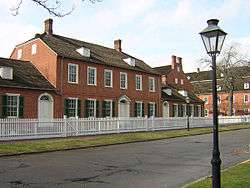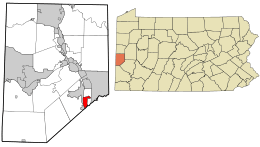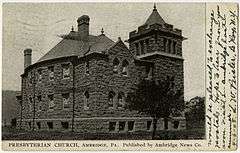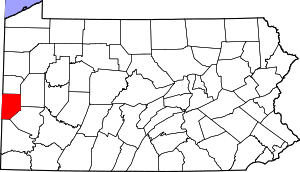Ambridge, Pennsylvania
Ambridge is a borough in Beaver County, Pennsylvania, United States. Incorporated in 1905 as a company town by the American Bridge Company, Ambridge is located 16 miles (25 km) northwest of Pittsburgh, along the Ohio River. The population was 7,050 at the 2010 census.
Ambridge, Pennsylvania | |
|---|---|
| Borough of Ambridge | |
 The Rapp House in Old Economy Village | |
| Motto(s): Home to Old Economy Village | |
 Location in Beaver County and the U.S. state of Pennsylvania. | |
| Coordinates: 40°35′35″N 80°13′31″W | |
| Country | United States |
| State | Pennsylvania |
| County | Beaver |
| Settled | 1824 |
| Incorporated | 1905 |
| Government | |
| • Type | Borough Council |
| • Mayor | David Drewnowski |
| Area | |
| • Total | 1.70 sq mi (4.40 km2) |
| • Land | 1.49 sq mi (3.85 km2) |
| • Water | 0.21 sq mi (0.55 km2) |
| Elevation | 764 ft (233 m) |
| Population (2010) | |
| • Total | 7,050 |
| • Estimate (2019)[2] | 6,601 |
| • Density | 4,442.13/sq mi (1,714.86/km2) |
| Time zone | UTC-5 (Eastern (EST)) |
| • Summer (DST) | UTC-4 (EDT) |
| Zip code | 15003 |
| Area code(s) | 724 |
| FIPS code | 42-02288 |
| Website | Borough of Ambridge |
Early history
The town is near the location of Legionville, the training camp for General "Mad" Anthony Wayne's Legion of the United States. Wayne's was the first attempt to provide basic training for regular U.S. Army recruits and Legionville was the first facility established expressly for this purpose.
The Harmony Society first settled the area in the early 19th century, founding the village of "Ökonomie" or Economy in 1824. Although initially successful, accumulating significant landholdings, the sect went into decline. By the end of the 19th century, only a few Harmonists remained. The Society was dissolved and its vast real estate holdings sold, much of it to the American Bridge Company, who subsequently enlarged the town and incorporated it as Ambridge in 1905.
Industry
American Bridge attracted thousands of immigrants who came to fulfill their dreams of work, freedom, and peace. The steel mills became the focal point of the town. Most of the employees were relatives of relatives and the small town grew, with wards separating the town into ethnic sections. In addition, many of the ethnicities had their own church, club, and musical group that sought to give immigrants a familiar place to be as well as to preserve their culture. Many were from Eastern and Southern Europe including Italian, Greek, Slovak, Croatian, Ukrainian, Polish, Slovene, and Carpartho-Rusyn to name a few.[3][4][5][6][7][8][9]
With the growth of the steel mills, Ambridge became a worldwide leader in steel production. The borough became known for bridge building, metal molding, and the manufacture of tubes (large iron pipes). During World War II, the American Bridge Company fabricated steel for the building of LSTs (Landing Ship Tanks). The steel was then sent by rail to the adjacent American Bridge naval shipyard in Leetsdale, Pennsylvania, where the LSTs were built. The area was also home to several other steel mills like Armco, the pipe mill which manufactured oil piping, and A.M. Byers, a major iron and tool fabricator. Eventually competition by foreign steel producers began to cause the share of the steel market for U.S. manufacturers to dwindle. With the shift of steel production overseas, the American Bridge Company ended operations in Ambridge in 1983. The legacy of American Bridge can be seen today in bridges around the world.
The decline of both the steel industry and the town in chronicled in Rust Belt Boy by Ambridge native Paul Hertneky.[10]
Current day
Even though the steel mills no longer dominate the landscape, Ambridge remains the home of Old Economy Village, a National Historic Landmark administered by the Pennsylvania Historical and Museum Commission. The site interprets the Harmony Society, one of America's most successful 19th century Christian communal societies. Old Economy Village also provides public education and preservation of the Society's unique material culture. Founded by George Rapp, it was the third and final location of the Harmonites. Established in 1824, Old Economy - known to the Harmonites as "Ökonomie" - was founded upon German Pietism, which called for a higher level of purity within Christianity. Soon the Harmonites were not only known for their piety, but also for their production of wool, cotton, and silk. As a pioneer in the American silk industry, Economy became known as the American silk center in the 1830s and 1840s. Today, the site maintains seventeen carefully restored structures and gardens that were built between 1824 and 1830. The buildings reflect the unusual life style of the organization, which, by the 1840s, was well renowned for its economic success in textile production. The site also portrays the community's involvement with agricultural production, railroads, and oil. The recreated gardens encompass more than 2 acres (8,100 m2), providing colorful 19th century flowers. The gardens' formal pathways, stone pavilion, and seasonal flowering hedges are among the striking features. Old Economy's buildings, grounds, library, archives and 16,000 original artifacts are fused to create an interpretive facility for the Commonwealth.
Although the different ethnic groups of Ambridge have blended over time, the community continues to recognize the origins from which it came. Since 1966, Ambridge has held an annual heritage festival celebrating the borough's ethnic pride. Diversity in food, music, and entertainment continues to unite the community in remembering its origins. Organized by the Ambridge Chamber of Commerce, the three-day Nationality Days festival takes place in May and is located in the heart of the downtown Commercial District. Vendors line the center of Merchant Street as thousands of attendees – locals and tourists – enjoy Italian, Ukrainian, Greek, Polish, German, Croatian, and Slovenian cuisine. Booths are sponsored by numerous churches in Ambridge, bringing with them the recipes for their cultural dishes such as pirohy, haluski, stuffed cabbage, and borscht. Live entertainment, arts and crafts, and children's activities are also available. Thousands visit this festival daily (located on Merchant Street from 4th Street to 8th Street).

With Ambridge now over 100 years old, revitalization is beginning to occur along Merchant Street in the Downtown Commercial District. Entrepreneurs and investors have begun to renovate the Victorian facades of the commercial storefronts. Antique shops are opening in the Historic District, which is also a National Historic Landmark, and a once industrial warehouse area is being converted to condominiums, shops, and parks. In 2007 Ambridge was designated as a Preserve America Community by the White House. Convenient to Pittsburgh along the Ohio River Boulevard and just across the Ohio River from the Pittsburgh Airport, Ambridge leaders hope it will benefit by its location and low cost of living.
Geography
Ambridge is located at 40°35′35″N 80°13′31″W (40.593167, -80.225200),[11] along the Ohio River.
According to the United States Census Bureau, the borough has a total area of 1.7 square miles (4.4 km2), of which 1.5 square miles (3.9 km2) is land and 0.2 square miles (0.5 km2) (12.87%) is water.
Surrounding and adjacent neighborhoods
Ambridge has two land borders, including Harmony Township to the north, east and northeast, and the Allegheny County borough of Leetsdale to the southwest. The city of Aliquippa runs adjacent to Ambridge across the Ohio River to the west and is connected to the borough via Ambridge-Aliquippa Bridge.
Demographics
| Historical population | |||
|---|---|---|---|
| Census | Pop. | %± | |
| 1910 | 5,205 | — | |
| 1920 | 12,730 | 144.6% | |
| 1930 | 20,227 | 58.9% | |
| 1940 | 18,968 | −6.2% | |
| 1950 | 16,429 | −13.4% | |
| 1960 | 13,865 | −15.6% | |
| 1970 | 11,324 | −18.3% | |
| 1980 | 9,575 | −15.4% | |
| 1990 | 8,133 | −15.1% | |
| 2000 | 7,769 | −4.5% | |
| 2010 | 7,050 | −9.3% | |
| Est. 2019 | 6,601 | [2] | −6.4% |
| Sources:[12][13] | |||
As of the census[14] of 2000, there were 7,769 people, 3,595 households, and 1,966 families residing in the borough. The population density was 5,179.3 people per square mile (2,044.5/km²). There were 4,099 housing units at an average density of 2,760.9 per square mile (1,069.3/km²). The racial makeup of the borough was 85.69% White, 11.38% African American, 0.08% Native American, 0.45% Asian, 0.01% Pacific Islander, 0.73% from other races, and 1.66% from two or more races. Hispanic or Latino of any race were 1.83% of the population.
There were 3,595 households, out of which 23.2% had children under the age of 18 living with them, 32.6% were married couples living together, 16.9% had a female householder with no husband present, and 45.3% were non-families. 39.8% of all households were made up of individuals, and 18.5% had someone living alone who was 65 years of age or older. The average household size was 2.14 and the average family size was 2.88.
In the borough the population was spread out, with 21.7% under the age of 18, 7.9% from 18 to 24, 27.2% from 25 to 44, 20.2% from 45 to 64, and 23.0% who were 65 years of age or older. The median age was 40 years. For every 100 females, there were 89.6 males. For every 100 females age 18 and over, there were 85.9 males.
The median income for a household in the borough was $26,263, and the median income for a family was $35,529. Males had a median income of $30,996 versus $21,455 for females. The per capita income for the borough was $15,089. About 16.4% of families and 17.8% of the population were below the poverty line, including 26.3% of those under age 18 and 14.1% of those age 65 or over.
Education
The town is served by the Ambridge Area School District. The town's high school is Ambridge Area High School. Students and citizens, are known by the locals as "Bridgers", which is also the name of the football team.
Ambridge is also home to Trinity School for Ministry, an evangelical seminary in the Anglican tradition.
See also
- List of cities and towns along the Ohio River
- Old Economy Village
- Harmony Society
- Ann B. Davis
- George Rapp
- Harmony, Pennsylvania
- New Harmony, Indiana
- David Zubik
- Elise Mercur
- Rock the World Youth Mission Alliance
References
- "2019 U.S. Gazetteer Files". United States Census Bureau. Retrieved July 28, 2020.
- "Population and Housing Unit Estimates". United States Census Bureau. May 24, 2020. Retrieved May 27, 2020.
- Slater, Larry (April 9, 2008). Ambridge(Images of America). Arcadia Publishing. ISBN 0738554863.
- "Christ The King church". Catholic Diocese of Pittsburgh. Archived from the original on 10 August 2016. Retrieved 13 April 2016.
- "Holy Trinity Ambridge". Catholic Diocese of Pittsburgh. Archived from the original on 9 August 2016. Retrieved 13 April 2016.
- "Divine Redeemer Ambridge". Catholic Diocese of Pittsburgh. Archived from the original on 9 August 2016. Retrieved 13 April 2016.
- "Saint Stanislaus, Ambridge". Catholic Diocese of Pittsburgh. Archived from the original on 9 August 2016. Retrieved 13 April 2016.
- "Holy Trinity Greek Orthodox Church". Holy Trinity Greek Orthodox Church of Ambridge. Archived from the original on 24 April 2016. Retrieved 13 April 2016.
- "Holy Ghost Orthodox Church, Ambridge, Pennsylvania". Holy Ghost Orthodox Church, Ambridge. Retrieved 13 April 2016.
- Behe, Rege (May 20, 2016). "Writer chronicles growing up in '60s Ambridge". Pittsburgh Tribune Review. Retrieved June 1, 2016.
- "US Gazetteer files: 2010, 2000, and 1990". United States Census Bureau. 2011-02-12. Retrieved 2011-04-23.
- "Census of Population and Housing: Decennial Censuses". United States Census Bureau. Retrieved 2012-03-04.
- "Incorporated Places and Minor Civil Divisions Datasets: Subcounty Resident Population Estimates: April 1, 2010 to July 1, 2012". Population Estimates. U.S. Census Bureau. Archived from the original on 11 June 2013. Retrieved 11 December 2013.
- "U.S. Census website". United States Census Bureau. Retrieved 2008-01-31.
External links
- Ambridge Area Chamber of Commerce The Ambridge Area Chamber of Commerce
- Ambridge Connection Local news and information
- Ambridge Borough site
- Old Economy Village museum interpreting the history of the Harmony Society
- Information on the Ohio River Bridge in Ambridge
- Ambridge Postcards from rootsweb.com
